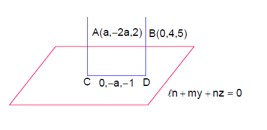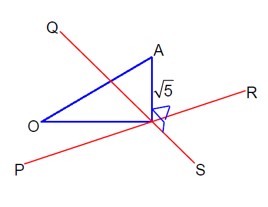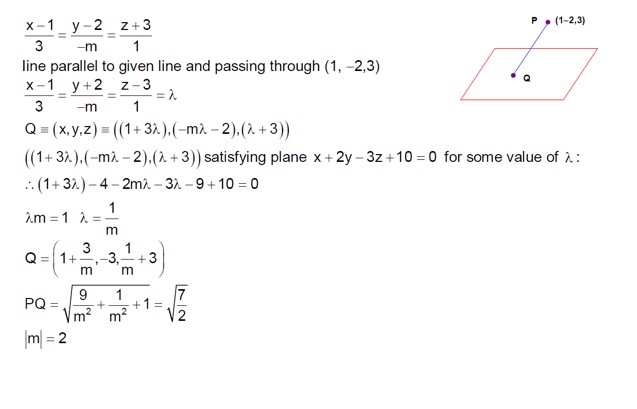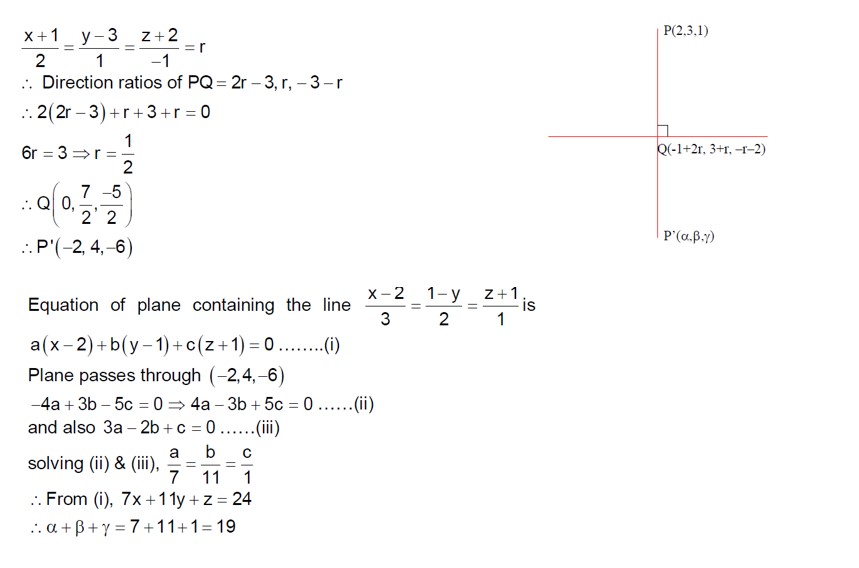Three Dimensional Geometry
Get insights from 212 questions on Three Dimensional Geometry, answered by students, alumni, and experts. You may also ask and answer any question you like about Three Dimensional Geometry
Follow Ask QuestionQuestions
Discussions
Active Users
Followers
New answer posted
2 months agoContributor-Level 10
The equation of the line is (x-2)/1 = (y-1)/1 = (z-6)/-2.
Let this be equal to k. So, a point on the line is (k+2, k+1, -2k+6).
This point lies on the plane x + y - 2z = 3.
(k+2) + (k+1) - 2 (-2k+6) = 3
2k + 3 + 4k - 12 = 3
6k - 9 = 3
6k = 12 ⇒ k = 2.
The point of intersection is (2+2, 2+1, -2 (2)+6) = (4, 3, 2).
New answer posted
2 months agoContributor-Level 9
PR (line): r = (3i - j + 2k) + λ (4i - j + 2k) - (I)
QS (line): r = (i + 2j - 4k) + μ (-2i + j - 2k) - (II)
If they intersect at T then:
3 + 4λ = 1 - 2μ
-1 - λ = 2 + μ
2 + 2λ = -4 - 2μ
Solving the first two equations gives λ = 2 & μ = -5. These values satisfy the third equation.
∴ T (11, -3, 6)
Also, OT is coplanar with lines PR and QS.
⇒ TA ⊥ OT
|OT| = √166
|TA| = √5
|OA| = √ (|OT|² + |TA|²) = √171
New answer posted
2 months agoContributor-Level 10
The shortest distance D between two skew lines is given by the formula:
D = | (a? - a? ) ⋅ (b? x b? )| / |b? x b? |
Line L? : (x-1)/2 = (y-2)/3 = (z-4)/4
Line L? : (x-2)/3 = (y-4)/4 = (z-5)/5
Here, a? = I + 2j + 4k, b? = 2i + 3j + 4k
a? = 2i + 4j + 5k, b? = 3i + 4j + 5k
a? - a? = I + 2j + k
b? x b? = | I j k |
| 2 3 4 |
| 3 4 5 |
= I (15-16) - j (10-12) + k (8-9) = -i + 2j - k
D = | (i + 2j + k) ⋅ (-i + 2j - k)| / √ (-1)² + 2² + (-1)²)
= |-1 + 4 - 1| / √ (1 + 4 + 1)
= 2 / √6
New answer posted
2 months agoContributor-Level 10
The equation of the plane is given as x + y + z = 42. It is also mentioned that x³ + y³ + z³ = 3xyz.
From the identity, if x³ + y³ + z³ - 3xyz = 0, then x + y + z = 0 or x = y = z.
Given the expression:
3 + (x³ + y³ + z³ - 3xyz) / (xyz)²
Since x³ + y³ + z³ = 3xyz, the expression simplifies to:
3 + 0 = 3
New answer posted
2 months agoContributor-Level 10
The equation of a plane is determined by a point it passes through and a normal vector. The plane passes through (1, -6, -5). Its normal vector (a, b, c) is perpendicular to two other vectors, derived from the given equations:
4a - 3b + 7c = 0
3a + 4b + 2c = 0
The direction of the normal vector (a, b, c) is found by the cross product of (4, -3, 7) and (3, 4, 2):
a = (-3) (2) - 7 (4) = -34.
b = 7 (3) - 4 (2) = 13.
c = 4 (4) - (-3) (3) = 25.
So the plane equation is -34 (x-1) + 13 (y+6) + 25 (z+5) = 0.
The point (1, -1, α) lies on this plane:
-34 (1-1) + 13 (-1+6) + 25 (α+5) = 0.
0 + 13 (5) + 25α + 125 = 0.
65 + 25α + 125 = 0 ⇒ 25α = -190
New answer posted
2 months agoContributor-Level 10
The vector PQ is given by Q - P = (-3-1, 5-3, 2-a) = (-4, 2, 2-a).
This vector is collinear with 2i - j + k = (2, -1, 1).
This means their components are proportional: -4/2 = 2/ (-1) = (2-a)/1.
From -2 = 2-a, we find a=4.
The midpoint M of PQ is (-3+1)/2, (5+3)/2, (2+4)/2) = (-1, 4, 3).
M lies on the plane 2x - y + z - b = 0.
Substitute the coordinates of M: 2 (-1) - 4 + 3 - b = 0 ⇒ -2 - 4 + 3 = b ⇒ b = -3.
New answer posted
2 months agoContributor-Level 10
Given a right-angled triangle with one angle π/3 (or 60°), and the side adjacent to it is h/2.
Using the tangent function: tan (π/3) = opposite / adjacent.
Let the adjacent side be 2. Then tan (π/3) = h/2.
We know tan (π/3) = √3.
So, h/2 = √3, which implies h = 2√3.
Taking an Exam? Selecting a College?
Get authentic answers from experts, students and alumni that you won't find anywhere else
Sign Up on ShikshaOn Shiksha, get access to
- 65k Colleges
- 1.2k Exams
- 679k Reviews
- 1800k Answers




